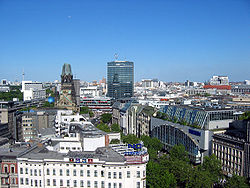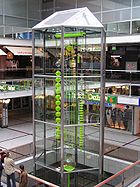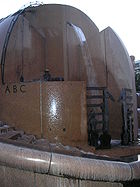
Europa-Center
Encyclopedia

Breitscheidplatz
Breitscheidplatz is a major public square in the inner city of Berlin, Germany. Together with the Kurfürstendamm boulevard it marks the centre of former West Berlin.-Geography:...
in Berlin
Berlin
Berlin is the capital city of Germany and is one of the 16 states of Germany. With a population of 3.45 million people, Berlin is Germany's largest city. It is the second most populous city proper and the seventh most populous urban area in the European Union...
, notable for its high-rise tower. During the 1960s it became one of the iconic sights of West Berlin
West Berlin
West Berlin was a political exclave that existed between 1949 and 1990. It comprised the western regions of Berlin, which were bordered by East Berlin and parts of East Germany. West Berlin consisted of the American, British, and French occupation sectors, which had been established in 1945...
, along with the Kaiser Wilhelm Memorial Church
Kaiser Wilhelm Memorial Church
The Protestant Kaiser Wilhelm Memorial Church is located in Berlin on the Kurfürstendamm in the centre of the Breitscheidplatz. The original church on the site was built in the 1890s. It was badly damaged in a bombing raid in 1943...
. It is a historically preserved
Historic preservation
Historic preservation is an endeavor that seeks to preserve, conserve and protect buildings, objects, landscapes or other artifacts of historical significance...
building.
History of the site
The site of the present-day Europa-Center, in "New West" Berlin (also known as "City-West"), was from 1916 home to the Romanisches CaféRomanisches Café
The Romanisches Café was a café-bar in Berlin well known as a meeting place for artists. It was located on the Kurfürstendamm in the Charlottenburg district...
, a legendary meeting place for writers, artists and people in the theatre business, as well as those who aspired to join them. After being bombed during the Second World War in November 1943 the building lay in ruins. For a decade the premises were used only intermittently, according to need. Makeshift constructions were used variously by wrestlers, circus performers and missionaries, followed by food outlets and briefly a cinema hosting so-called Sittenfilme ("films of manners
Novel of manners
The novel of manners is a literary genre that deals with aspects of behavior, language, customs and values characteristic of a particular class of people in a specific historical context. The genre emerged during the final decades of the 18th century. The novel of manners often shows a conflict...
"). A local newspaper described the site as a "stain on Berlin's calling card".
Construction


Berlin Wall
The Berlin Wall was a barrier constructed by the German Democratic Republic starting on 13 August 1961, that completely cut off West Berlin from surrounding East Germany and from East Berlin...
, in 1961, the situation changed. New buildings were politically desirable and were encouraged as symbols of West Berlin
West Berlin
West Berlin was a political exclave that existed between 1949 and 1990. It comprised the western regions of Berlin, which were bordered by East Berlin and parts of East Germany. West Berlin consisted of the American, British, and French occupation sectors, which had been established in 1945...
's vitality and durability. The Breitscheidplatz, a square in the central part of West Berlin, needed further improvement in addition to the recently finished Kaiser Wilhelm Memorial Church. The successful Berlin businessman and investor Karl Heinz Pepper was appointed to oversee construction. He commissioned Helmut Hentrich and Hubert Petschnigg
Hubert Petschnigg
Hubert Petschnigg was an Austrian architect.-Life:Petschnigg was born in Klagenfurt, and went to school in Villach. In 1934 he began to study architecture at the Vienna University of Technology, where he entered the Hansea Vienna branch of the Kösener Corps student society...
to design and build an office and shopping centre following the American model. Egon Eiermann
Egon Eiermann
Egon Eiermann was one of Germany's most prominent architects in the second half of the 20th century....
, architect of the Memorial Church, was involved as an artistic advisor. Construction work began in 1963, and on 2 April 1965 the Europa-Center was inaugurated by Mayor Willy Brandt
Willy Brandt
Willy Brandt, born Herbert Ernst Karl Frahm , was a German politician, Mayor of West Berlin 1957–1966, Chancellor of West Germany 1969–1974, and leader of the Social Democratic Party of Germany 1964–1987....
.
What had been built was a complex with a total floor space of 80,000 square metres, divided into distinct units: a two-storey foundation with a basement and two inner courtyards, a cinema, a hotel, an apartment block, and the box-shaped high-rise with a height of 86m, 21 storeys and 13,000 square metres of office space. At the time the high-rise was the only one of its kind in Berlin, and hence was a defining feature of Berlin's urban geography, frequently referenced in other designs. Numerous renovations and modernisations since then have served to increase the attractiveness and hence the commercial success of the building. For example the inner courtyards have been given canopies, and the skating rink in one of the courtyards was removed in 1979. In 2005 the operators of the complex gave the number of shops and food outlets as around 100, with between 20,000 and 40,000 visitors daily.
Notable features

Mercedes-Benz
Mercedes-Benz is a German manufacturer of automobiles, buses, coaches, and trucks. Mercedes-Benz is a division of its parent company, Daimler AG...
. It weighs 15,000 kg, has an outer diameter of 10 metres, completes approximately two revolutions a minute, and glows at night with the help of 68 fluorescent tubes. It can be tilted back for maintenance work, and in stormy weather it automatically turns into the wind.
The "Clock of Flowing Time" (Uhr der fließenden Zeit) in the western courtyard portrays the passing of hours and minutes in twelve-hour cycles. Globules of coloured water flow up and down a tower through a system of communicating tubes in such a way as to display the current time. The system is emptied every day at 1am and 1pm and the cycle begins again.

Paris
Paris is the capital and largest city in France, situated on the river Seine, in northern France, at the heart of the Île-de-France region...
ian artists Bernard and Francois Baschet, a "water play" with optical and acoustical elements. It was originally commissioned for the staircase of Berlin's New National Gallery and was installed there in 1975. It was deemed expendable in 1981 and was transferred to the Europa-Center in 1982 for free as an extended loan.
External links
- Website of the Europa-Center in Berlin (English version)

